new posts in all blogs
Viewing: Blog Posts Tagged with: sherlock holmes, Most Recent at Top [Help]
Results 1 - 25 of 59
How to use this Page
You are viewing the most recent posts tagged with the words: sherlock holmes in the JacketFlap blog reader. What is a tag? Think of a tag as a keyword or category label. Tags can both help you find posts on JacketFlap.com as well as provide an easy way for you to "remember" and classify posts for later recall. Try adding a tag yourself by clicking "Add a tag" below a post's header. Scroll down through the list of Recent Posts in the left column and click on a post title that sounds interesting. You can view all posts from a specific blog by clicking the Blog name in the right column, or you can click a 'More Posts from this Blog' link in any individual post.
It’s back! I’ve been doing my thing, buying lovely adult titles for my library system, and time and again I’ve run across ideas or names that fall squarely in the children’s book realm. Here then are some real beauties. Things you just might not know about otherwise.
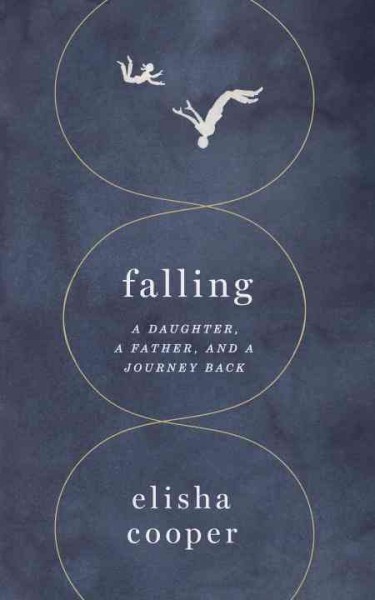
I know and like Elisha Cooper but I’m ashamed to say that before this book was announced I was unaware of his previous memoir A Father’s First Year which was released in 2006. Since that time, Cooper’s daughter was diagnosed at the age of four with pediatric kidney cancer. This book examines her treatment, recovery, and what this all did to Elisha himself. On my To Be Read Shelf.

Thus continuing my series of books about people I know or have met, and yet never had any idea about when it comes to their personal lives. In this upcoming August memoir, Nadja (who penned Lost in NYC amongst other things) opens up about herself, her mother, and even her grandmother. It’s a deeply personal work about someone I’m desperately fond of (Francoise Mouly, Nadja’s mother, is the founder of TOON Books, as well as serving as the Art Director of The New Yorker, and she is delight incarnate). Also on the To Be Read Shelf.
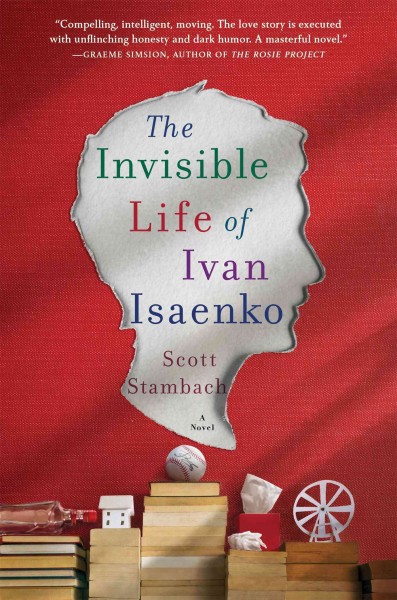
This inclusion is a bit of a stretch. I really only put it here because in the Library Journal review of the book it said, “Soviet-style medical ethics or lack thereof frame an intimate story that the publicist calls One Flew over the Cuckoo’s Nest crossed with The Fault Is in Our Stars.” So there’s that.

Jackie writes something for adults and people get very excited. Book Expo America hasn’t even happened yet, but I’ve already been seeing this title showing up on lists of Best Books of the Summer and what have you. I foresee some libraries have problems cataloging this title (the cover looks awfully similar to her YA novels and will be easily confused) but for all that, I suspect it’s going to be a book club hit and a New York Times bestseller. Just you wait, just you wait . . .
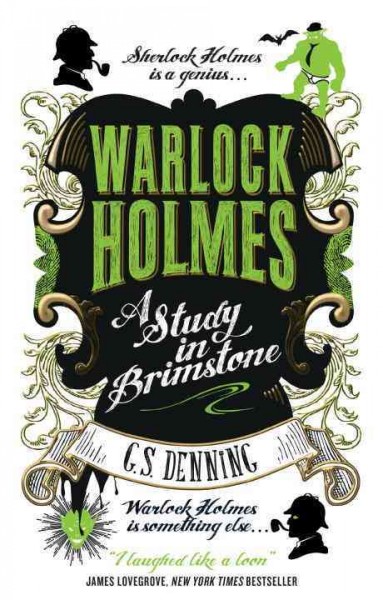
No further comments, your honor.
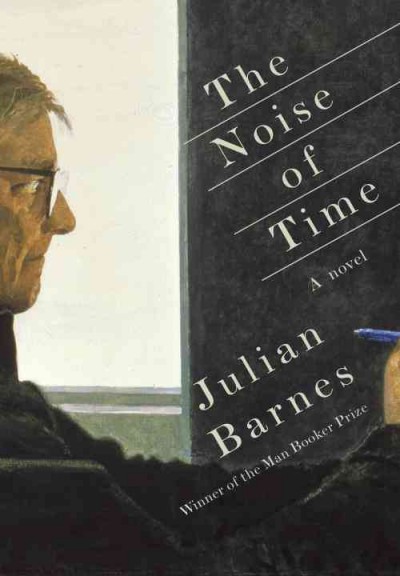
For those of us floored by M.T. Anderson’s Symphony for the City of the Dead last year, here is a new biography of its star, Dmitri Shostakovich. And it’s a novel. It’s out May 10th. Look for it.

A Garth Williams biography! Whodathunkit? Seems pretty specialized and for a veeeery small market, but there you are. I know the estate of Williams doesn’t exactly bend over backwards to allow folks to use his art (even his obscure art) in any context. They must have approved of this book from the start. Heck, I’ll read it.

 Titan Comics will publish an English translation of the Sherlock manga series. These comic books, adapted from the popular BBC television series, were originally published in Japan four years ago.
Titan Comics will publish an English translation of the Sherlock manga series. These comic books, adapted from the popular BBC television series, were originally published in Japan four years ago.
Entertainment Weekly reports that Jay, an illustrator, created the artwork. The release date for Sherlock: A Study In Pink has been scheduled for June 2016.
Here’s more from io9: “To make up for the fact that fan translations have been widely distributed in the four years since the manga released in Japan, Titan’s release will include an increased page count, new alternate covers, and bonus art from frequent Titan collaborator Alice X. Zhang. It will also be available in both physical and digital formats.” (via Comic Book Resources)
BBC One has unveiled a video on “Taking Sherlock Back To Victorian Times.” The video embedded above showcases a behind-the-scenes look at the Sherlock: The Abominable Bride special.
Here’s more from The Hollywood Reporter: “Sherlock: The Abominable Bride, the much-anticipated 90-minute special of the BBC hit show starring Benedict Cumberbatch and Martin Freeman, on Friday drew an average audience of 8.4 million in Great Britain, according to overnight data. That made the drama the day’s most-watched show in the U.K. and amounted to a share of 34.7 percent of people watching TV in the country at the time, according to the BBC.”
Click on these links to see the first trailer and the second trailer. Follow this link to download a free digital copy of Sir Arthur Conan Doyle’s The Adventures of Sherlock Holmes. (via The Wall Street Journal)
Summary: The beginning of a series of posts about my Sherlock Holmes thesis project showing preliminary sketches.
via Studio Bowes Art Blog at http://ift.tt/1YKWlld
The BBC has unleashed a second trailer for a Sherlock special. The Independent reports that this Victorian-themed episode is called “The Abominable Bride.”
Here’s more from Digital Spy: “Over 100 cinemas will be simulcasting the highly-anticipated Sherlock special on January 1, 2016, and now BBC is sharing further details of what fans can expect from the screenings…In addition to showing the one-off, 90-minute Victorian special, those who book their seats will also get to see extra filmed material, including a guided tour of 221B Baker Street from co-creator Steven Moffat and a look behind the scenes at how the episode was made, featuring the lead cast and crew.”
The video embedded above features scenes with Benedict Cumberbatch in the titular role and Martin Freeman playing Dr. John Watson. Follow this link to see the first trailer. Click here to download a free digital copy of Sir Arthur Conan Doyle’s The Adventures of Sherlock Holmes. (via io9)
By: Sharon Ledwith,
on 9/28/2015
Blog:
Sharon Ledwith: I came. I saw. I wrote.
(
Login to Add to MyJacketFlap)
JacketFlap tags:
Grey's Anatomy,
CSI,
Bones,
Arthur Conan Doyle,
Writing Process,
Writing,
Sherlock Holmes,
NCIS,
Writing Strategies,
Killing off Characters,
Add a tag
My hubby and I have an ongoing joke. When a character is killed off or leaves a TV show, we call it a contract dispute. For example, the character of Lance Sweets from the show Bones was killed in the Season 10 opener. Boy that was a shocker! Other major characters have left or met their demise on other popular shows such as NCIS and CSI. The most recent contract dispute falls in the lap of Doctor Derek Shepherdwho went out with a bang (literally) when his car gets T-boned by a truck, and he hangs on for dear life for at least a couple more episodes of Grey’s Anatomy. A sad day indeed. Sniff.
The exit of these characters got me thinking. When is it the right time to kill or remove a character from an ongoing book series? Is it when the character stops meeting the readers’ needs and expectations? Do the characters become boring? Stop growing? Refuse to change? Perhaps. I guess the best sounding board would be the readers. Listening to them on the social media or reading the reviews they post. Are they sick of Character X? Does Character Y make them want to vomit? Or do readers even relate to Character Z? Mind you, I’m not sure killing a character off would have the same effect in sales as it does for TV ratings, but you never know until you try. Bahaha…
 However, if you kill the wrong character you’ll have blood on your hands and angry readers. Case in point—when Arthur Conan Doyle killed Sherlock Holmes by sending him over a waterfall with his arch enemy Professor Moriarty in tow, it wasn’t pretty. I mean for Sir Arthur, and the readers demanded satisfaction. Seriously? What was he thinking? Note to self: don’t piss your fans off!
However, if you kill the wrong character you’ll have blood on your hands and angry readers. Case in point—when Arthur Conan Doyle killed Sherlock Holmes by sending him over a waterfall with his arch enemy Professor Moriarty in tow, it wasn’t pretty. I mean for Sir Arthur, and the readers demanded satisfaction. Seriously? What was he thinking? Note to self: don’t piss your fans off!
In my time travel series, The Last Timekeepers, I’ve seriously thought about replacing certain characters to freshen up the series as it progresses, although nothing is written in stone yet. Readers are continually looking for new and improved characters to keep them invested in any series. That’s the reason why TV shows keep introducing new characters into a series. Even J.K. Rowling added new characters (and killed off a bunch) throughout her Harry Potter series.
So my question is: when must a character die or leave? I’m guessing there are so many answers to that question, but the reason I’d off one of my characters is when there’s no more room for character development or growth. That’s what Sir Arthur Conan Doyle attempted to do when he killed off Sherlock Holmes—he tied up all the loose ends and made sure Holmes lived a full life. Unfortunately, Doyle underestimated his readers, even though he wanted to cash out and move on to writing other books. And to this day, Sherlock Holmes has survived his creator, and duped death. Now that’s one loved character!
Thank you for reading my blog! So, what characters would you like to see killed/removed from your favorite book series? Love to hear your answers! Cheers!

By: KatherineS,
on 9/9/2015
Blog:
OUPblog
(
Login to Add to MyJacketFlap)
JacketFlap tags:
The Adventures of Sherlock Holmes,
Mr. Holmes,
British fiction,
dr watson,
hound of the baskervilles,
quiz,
fiction,
short stories,
sherlock holmes,
detective,
OWC,
sherlock,
Oxford World's Classics,
arthur conan doyle,
*Featured,
A Study in Scarlet,
Quizzes & Polls,
Series & Columns,
Arts & Humanities,
Baker Street,
Literature,
Add a tag
Test your knowledge of Sherlock Holmes with this quiz, based on the novels and short stories, the canon's history and its place in modern day life.
The post How well do you know Sherlock Holmes? [quiz] appeared first on OUPblog.

By: Helena Palmer,
on 7/7/2015
Blog:
OUPblog
(
Login to Add to MyJacketFlap)
JacketFlap tags:
fiddler on the roof,
classical music,
sherlock,
Proms,
Stravinsky,
*Featured,
Alyn Shipton,
Sir Arthur Conan Doyle,
Orchestral Music,
Online products,
BBC Proms,
Ralph Vaughan Williams,
Nilsson,
william walton,
Arts & Humanities,
Proms in the Park,
Books,
Music,
Journals,
opera,
BBC,
Sondheim,
reading list,
sherlock holmes,
bollywood,
orchestra,
Composing,
Bach,
Gershwin,
ezra pound,
composers,
Add a tag
In celebration of The BBC Proms 120th anniversary we have created a comprehensive reading list of books, journals, and online resources that celebrate the eight- week British summer season of orchestral music, live performances, and late-night music and poetry.
The post Happy 120th birthday BBC Proms appeared first on OUPblog.
 Designers Adam Frost and Jim Kynvin have created a series of infographics for Sherlock Holmes fans which map different data points about the books.
Designers Adam Frost and Jim Kynvin have created a series of infographics for Sherlock Holmes fans which map different data points about the books.
For instance, one graphic shows out how many stories each character appears in and another breaks out the different types of clients that have hired Holmes.
The Guardian has the entire collection here.
By:
Sue Morris @ KidLitReviews,
on 4/13/2015
Blog:
Kid Lit Reviews
(
Login to Add to MyJacketFlap)
JacketFlap tags:
Middle Grade,
mystery,
Favorites,
Series,
Sherlock Holmes,
Books for Boys,
suspense,
5stars,
Library Donated Books,
F. C. Shaw,
Future House Publishing,
Add a tag

x
Sherlock Academy
Written by F. C. Shaw
Future House Publishing 3/16/2015*
978-0-09891253-4-5
214 pages Age 8—12
x
“Teachers in disguise. Secret libraries, hollow books . . . All these and more await eleven-year-old Rollie Wilson at the mysterious Academy of Fine Sleuths. When Rollie and his best friend, Cecily, are invited to attend a school where children learn the art of detection just like the great Sherlock Holmes, they discover a strange burglary has been committed and a mystery is a foot. Determined to investigate, Rollie discovers that appearances can be deceiving, the truth can be hurtful, and friends sometimes turn into foes. Does Rollie have what it takers to follow in Holmes footsteps? Can he use his skills to solve the mystery and save the school from an unknown villain?”
The Story
Rollie Wilson is the middle child of five and the only non-twin. That makes it difficult for Rollie to gain his family’s attention; even Great Auntie Ei, who shows Rollie both attention and affection, finds herself preoccupied with Herr Zilch , a mastermind thief who continues to allude Scotland Yard. But when an invitation arrives for Rollie, the entire family is interested.
“Rollie E. Wilson:
“It is our pleasure to inform you of your eligibility for the Sherlock Holmes Academy of Fine Sleuths. We believe you possess the qualities we seek in fine students . . . bring only the following item [to orientation]: your favorite book.”
Rollie’s best friend, Cecily, also receives an invitation, and both are admitted, each taking their favorite Sherlock Holmes book, which is placed into a strange library by staff. To get their book back, students must figure out how the library shelves work. No student has ever figured the out the secret or retrieved their book. Rollie intends to be the first, but is interrupted. Someone has broken into the library, for what no one knows—or is saying. Deciphering all the secrets (library, teachers,and other characters), will put Rollie and his family into grave danger.
Review
Sherlock Academy will not only entertain readers, it might just encourage kids to learn about codes—explained well in the story—or to simply pick up a Sherlock Holmes story for the first time. The characters are will developed. Rollie and his best buddy Cecily solve most every question by asking themselves five basic questions about the problem or situation at hand: Who? What? Why?, When? and How?
Rollie and Cecily have been neighborhood detectives for quite sometime, often using binoculars to spy on Mr. Crenshaw, Rollie’s next-door neighbor. Crenshaw enjoys this sleuthing, often waving back or inviting the two junior sleuths in for tea and sending Auntie Ei chocolates (which she loves). Careful observation will glean that Crenshaw’s activities are the first of many clues that somethings are not always what they seem to be.
My only negative, to me, was how easy it is to figure out where Auntie Ei’s nemesis, Herr Zilch, is hiding between criminal acts, though his plans took me by surprised. There are several characters with secrets, including the eighty-year-old aunt, which are not evident until the end. The author does a great job of teasing the reader and then sending them in a new direction, once again confusing things. Rollie, being good detective—with his Watson (Cecily)—figures out most mysteries, but has a final surprise that leads him, and readers, to book 2.
This is year one for Rollie and Cecily at Sherlock Academy. What will Shaw put them in the middle of during year two is something I cannot wait to discover. Sherlock Academy is a wonderful mystery even younger kids can enjoy. There are a few detective terms that might send them to a dictionary (always a good thing), but over all. Sherlock Academy, with its well-written story, will keep readers turning the pages and entertaining them until the very mysterious end. Herr Zilch should return as Rollie’s nemesis, as will the teachers, plus probably one new goofball to replace the one that leaves. If you like mysteries, if you like Sherlock Holmes, if you like relatively fast reads with well-kept secrets and a nice flow, well, then Sherlock Academy is the new series for you. Enjoy!
SHERLOCK ACADEMY. Text copyright © 2015 by F. C. Shaw. Reproduced by permission of the publisher, Future House Publishing, Orem, UT.
*First published on July 31, 2009
X
Purchase Sherlock Academy at Amazon —Book Depository.
—Book Depository.
X
Learn more Sherlock Academy HERE.
Meet the author, F. C. Shaw, at her website: www.sherlockacademy.com
Find other middle grade novels at the Future House Publishing website: www.futurehousepublishing.com
 x
x
x
original cover
X. . . . . . . F
Full Disclosure: Sherlock Academy, by F. C. Shaw, and received from Future House Publishing, is in exchange NOT for a positive review, but for an HONEST review. The opinions expressed belong to Kid Lit Reviews and no one else’s. This is disclosed in accordance with the Federal Trade Commission’s 16CRF, Part 255: Guidelines Concerning the Use of Endorsements and Testimonials in Advertising.
Copyright © 2015 by Sue Morris/Kid Lit Reviews
Filed under:
5stars,
Books for Boys,
Favorites,
Library Donated Books,
Middle Grade,
Series Tagged:
F. C. Shaw,
Future House Publishing,
mystery,
Sherlock Holmes,
suspense 







Today was definitely a Monday if ever there was one. I decked myself out in green and was so excited it was St Patrick’s Day. I actually have Irish heritage so I can really claim the day. When I got on the bus with my neighbor she saw my green dress and green cardigan sweater and said, gee you should have waited to wear that tomorrow. Huh? Why? Because tomorrow is St. Patrick’s Day, she said. No, it’s today, I replied. She looked at me and started laughing. No, tomorrow, on the 17th. So far no one has come to take away my right to say kiss me I’m Irish but I wouldn’t be surprised if my license gets revoked.
Then when I got to work my default printer to which all my circulation stuff is set up to print refused to wake up from its slumbers. I print a list of books to pull from the shelves every morning to send to other libraries in my consortium and I only have a short time to get this done because I have to open the library. I am the only one at the service desk to take care of this. The printer is one of those huge multi-function monstrosities that prints, scans, faxes, copies, and lurks in the corner with a surly teenager attitude. I had to take the drastic measure of restarting it. It’s easy enough to turn it off and on, but the thing takes ten minutes, sometimes longer, to reboot and run through all its diagnostics and who knows what else.
Why not print to another printer you ask? In the glorious world of library software we have, I would have had to close down my circulation program, change my computer printer default settings, then reopen the circulation software which itself take far longer than it should to start up. So I ran around the four floors of the library doing library opening stuff, came back to the desk and the printer was up. I pressed print for my list and had two minutes to pull five books from the shelves. I sprinted upstairs and made a mad dash through the stacks, barreled back down the stairs and got the doors open just in time. Luck of the Irish or just a crazy librarian at work?
Things got better as the day progressed but there were some trying moments.
On a more bookish note, I turned in my review of The Great Detective by Zach Dundas to Library Journal yesterday. What a fun read it was! I can’t really give it a full review here, but I did mention already about the first illustration of Sherlock Holmes. The rest of the book goes apace. It’s one of those books that does many things at once and combines personal experience/fandom, biography, literary criticism, cultural criticism, and a general attitude of “what a great adventure all this is.”
It is light and entertaining, a survey with a few lingering moments of strolling in a bit deeper, but not much. If you are a Holmes fan who has done a lot of reading about the great detective then the book is not for you. However, if you, like me, have read a story or two and watched a good many movie and TV adaptations but didn’t know much about Conan Doyle or any of the inspiration behind the stories, then you will very likely enjoy the book quite a lot. Look for it at your library or local bookstore and enjoy the read!
Filed under:
Books Tagged:
Sherlock Holmes 

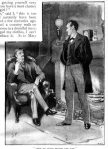
Holmes standing before the fire
Ah, the magic of the internet! It allows us to see amazing things from the comfort of a favorite chair when just twenty years ago we would have been out of luck.
I was reading The Great Detective by Zach Dundas at lunch today and he was talking about the beginnings of the Sherlock Holmes stories and how they took off when the second Holmes story appeared in The Strand Magazine in July, 1891. He mentions you can read it on your iPad. He talks about the stories and illustrations not only in the Conan Doyle piece but in the whole magazine.
It is in the Strand story, “A Scandal in Bohemia,” where the first drawing of Sherlock Holmes was made. It is a drawing that set the stage for how we still picture the great detective. And I thought, oh how neat! It would would fun to see it. But just on that alone I really had no plans on trying to find it. Until, that is, Dundas mentions an article in the same issue called “A Regiment on Wheels.” It is about a military regiment of bicyclists and there are illustrations demonstrating, among other things, a cyclist decapitating someone with a saber while riding his bike! Now that I had to see!
So to recap thus far: first drawing of Sherlock Holmes, not worth the bother of doing an internet search; drawing of a
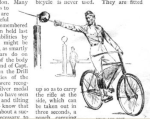
Swords & bikes – who knew?
cyclist decapitating someone with a sword, totally worth the effort to find.
The Internet Archive has the magazine, volume 2, number 7. You can view it online or download it as a PDF or several other file formats. Nifty.
To my credit, I found the Holmes drawing first and yes, he is exactly how you imagine him.
I did not linger long, however, there was a decapitation to find!
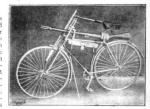
Pimp my bicycle
Of course it ends up being a bit disappointing. The cyclist isn’t actually decapitating a person but merely practicing by knocking a “head” off a post. I’m not entirely certain what I was expecting to see, but it wasn’t that. Nonetheless, it is an impressive skill to have and I might begin practicing it on my own bike. Perhaps I will use a stick though since I don’t imagine my neighbors would appreciate me riding up and down the street with a sword in my hand. There are children on my block after all. They would think it was cool and want to try too which would not endear me to their parents and I need to make sure my neighbors like me at least until I get them to sign off on my chicken permit. Then look out! I’m going to pimp my bike and when the zombie apocalypse comes I will be ready to make some zombie heads roll.
Filed under:
Books Tagged:
Sherlock Holmes 

A trailer has been unleashed for the Mr. Holmes movie. The video embedded above offers glimpses of Sir Ian McKellen playing an elderly Sherlock Holmes.
The actor announced on his Facebook page that this story shows “Sherlock Holmes as you’ve never seen him.” This film is set to hit U.K. theaters in Summer 2015; no U.S. release date has been announced yet.
Here’s more from E! Online: “Before the elderly detective digs into an unsolved case involving a mysterious young woman, McKellen begins to spend a lot of his time with a curious young boy played by Milo Parker. While the inquisitive youngster is deeply intrigued by the detective’s life, McKellen is a bit more focused on trying to remember a few clues that could crack the final mystery.” (via Entertainment Weekly)
 A new short story called “Sherlock Holmes: Discovering the Border Burghs and, by deduction, the Brig Bazaar” has been uncovered. Sir Arthur Conan Doyle wrote the 1,300-word piece more than 80 years ago.
A new short story called “Sherlock Holmes: Discovering the Border Burghs and, by deduction, the Brig Bazaar” has been uncovered. Sir Arthur Conan Doyle wrote the 1,300-word piece more than 80 years ago.
It appears in a collection entitled The Book o’ the Brig; the money generated from sales of this booklet benefited a small Scottish town called Selkirk. At the time of its publication, the local residents were collecting money so that they could re-construct a fallen bridge.
The Telegraph reports that historian Walter Elliot forgot that he owned a copy of this anthology; it had been sitting in his attic for over five decades. “It is believed the story – about Holmes deducing Watson is going on a trip to Selkirk – is the first unseen Holmes story by Doyle since the last was published over 80 years ago…The booklet will be on show at the Cross Keys Selkirk Pop-up Community Museum from Saturday, along with Mr Elliot’s painting of the replaced bridge.” Click here to read the full story. (via BuzzFeed)
Nothing to do with the theme. This is from an exquisite-corpse sort of project organized by an agency primarily funded by the state of Connecticut to promote literacy and the humanities. Twelve writers each get to contribute a chapter to an ebook with a plot built around various Connecticut landmarks and historical figures, making up the story as it is passed along, and each chapter is illustrated by a different illustrator. I got Chapter 6, in which one of the kids in the story encounters William Gillette, a stage actor famous in the early 20th century for his portrayal of Sherlock Holmes.
As part of the promotion for the new Sherlock Holmes book “Moriarty” the good people of Orion Books have a come up with a great competition. Click the image below to get the full details and good luck!
Sherlock Holmes Moriarty Compeition


By: Dionna Hargraves,
on 4/27/2014
Blog:
OUPblog
(
Login to Add to MyJacketFlap)
JacketFlap tags:
Journals,
Philosophy,
sherlock holmes,
stephan,
higgs,
reasoning,
alternatives,
*Featured,
Physics & Chemistry,
oxford journals,
Science & Medicine,
Bayes nets,
BJPS,
Jan Sprenger,
No Alternatives Argument,
Richard Dawid,
ritish Journal for the Philosophy of Science,
Stephan Hartmann,
dawid,
sprenger,
hartmann,
siddharth,
krish,
Add a tag
By Richard Dawid, Stephan Hartmann, and Jan Sprenger
“When you have eliminated the impossible, whatever remains, however improbable, must be the truth.” Thus Arthur Conan Doyle has Sherlock Holmes describe a crucial part of his method of solving detective cases. Sherlock Holmes often takes pride in adhering to principles of scientific reasoning. Whether or not this particular element of his analysis can be called scientific is not straightforward to decide, however. Do scientists use ‘no alternatives arguments’ of the kind described above? Is it justified to infer a theory’s truth from the observation that no other acceptable theory is known? Can this be done even when empirical confirmation of the theory in question is sketchy or entirely absent?
The canonical understanding of scientific reasoning insists that theory confirmation be based exclusively on empirical data predicted by the theory in question. From that point of view, Holmes’ method may at best play the role of a side show; the real work of theory evaluation is done by comparing the theory’s predictions with empirical data.
Actual science often tells a different story. Scientific disciplines like palaeontology or archaeology aim at describing historic events that have left only scarce traces in today’s world. Empirical testing of those theories always remains fragmentary. Under such conditions, assessing a theory’s scientific status crucially relies on the question of whether or not convincing alternative theories have been found.
Just recently, this kind of reasoning scored a striking success in theoretical physics when the Higgs particle was discovered at CERN. Besides confirming the Higgs model itself, the Higgs discovery also vindicated the judgemental prowess of theoretical physicists who were fairly sure about the existence of the Higgs particle already since the mid-1980s. Their assessment had been based on a clear-cut no alternatives argument: there seemed to be no alternative to the Higgs model that could render particle physics consistent.
Similarly, string theory is one of the most influential theories in contemporary physics, even in the absence of favorable empirical evidence and the ability to generate specific predictions. Critics argue that for these reasons, trust in string theory is unjustified, but defenders deploy the no alternatives argument: since the physics community devoted considerable efforts to developing alternatives to string theory, the failure of these attempts and the absence of similarly unified and worked-out competitors provide a strong argument in favor of string theory.
These examples show that the no alternatives argument is in fact used in science. But does it constitute a legitimate way of reasoning? In our work, we aim at identifying the structural basis for the no alternatives argument. We do so by constructing a formal model of the argument with the help of so-called Bayesian nets. That is, the argument is analyzed as a case of reasoning under uncertainty about whether a scientific theory H (e.g. string theory) is right or wrong.
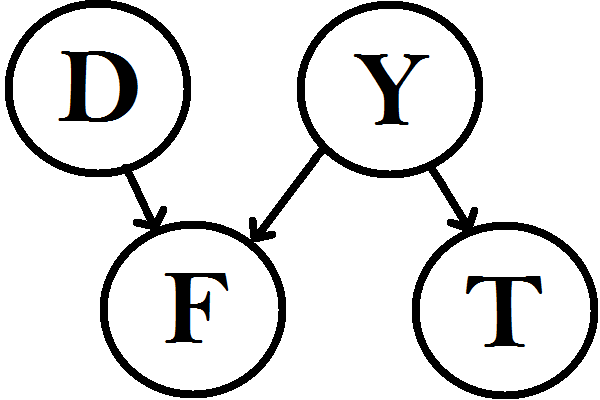
A Bayes nets that captures the inferential relations between the relevant propositions in the no alternatives argument. D=complexity of the problem, F=failure to find an alternative, Y=number of alternatives, T=H is the right theory.
We argue that the failure of finding a viable alternative to theory H, in spite of many attempts by clever scientists, lowers our expectations on the number of existing serious alternatives to H. This provides in turn an argument that H is indeed the right theory. In total, the probability that H is right is increased by the failure to find an alternative, demonstrating that the inference behind the no alternatives argument is valid in principle.
There is an important caveat, however. Based on the no alternatives argument alone, we cannot say how much the probability of the theory in question is raised. It may be substantial, but it may only be a tiny little bit. In that case, the confirmatory force of the no alternatives argument may be negligible.
The no alternatives argument thus is a fascinating mode of reasoning that contains a valid core. However, determining the strength of the argument requires going beyond the mere observation that no alternatives have been found. This matter is highly context-sensitive and may lead to different answers for string theory, paleontology and detective stories.
Richard Dawid, Stephan Hartmann, and Jan Sprenger are the authors of “The No Alternatives Argument” (available to read for free for a limited time) in the British Journal for the Philosophy of Science. Richard Dawid is lecturer (Dozent) and researcher at the University of Vienna. Stephan Hartmann is Alexander von Humboldt Professor at the LMU Munich. Jan Sprenger is Assistant Professor at Tilburg University. Their work focuses on the application of probabilistic methods within the philosophy of science.
For over fifty years The British Journal for the Philosophy of Science has published the best international work in the philosophy of science under a distinguished list of editors including A. C. Crombie, Mary Hesse, Imre Lakatos, D. H. Mellor, David Papineau, James Ladyman, and Alexander Bird. One of the leading international journals in the field, it publishes outstanding new work on a variety of traditional and cutting edge issues, such as the metaphysics of science and the applicability of mathematics to physics, as well as foundational issues in the life sciences, the physical sciences, and the social sciences.
Subscribe to the OUPblog via email or RSS.
Subscribe to only philosophy articles on the OUPblog via email or RSS.
The post Inferring the unconfirmed: the no alternatives argument appeared first on OUPblog.


By: PennyF,
on 4/1/2014
Blog:
OUPblog
(
Login to Add to MyJacketFlap)
JacketFlap tags:
holmes’,
doyle’s,
wakes,
Literature,
short stories,
mystery,
garden,
sherlock holmes,
holmes,
april fools,
Oxford World's Classics,
arthur conan doyle,
Humanities,
sherlock,
*Featured,
Add a tag

Here at Oxford University Press we occasionally get the chance to discover a new and exciting piece of literary history. We’re excited to share the newest short story addition to the Sherlock Holmes mysteries in Sherlock Holmes: Selected Stories. Never before published, our editorial team has acquired The Mystery of the Green Garden, now believed to be Sir Arthur Conan Doyle’s first use of the Sherlock Holmes’ character in his writing. Written during Doyle’s time at Stonyhurst College before entering medical school, the short story displays an early, amateur style of writing not seen in his later published works.
The Mystery of the Green Garden is set during Sherlock Holmes’ childhood – a rarely discussed part of Holmes’ life. Holmes’ is only sixteen years old when he is called to his first case. Unlike many of the stories in the Holmes series which are narrated by the loyal Dr. Watson, Holmes himself tells the short, endearing tale of his mother’s beloved garden. Getting our first look at his parents, Holmes briefly describes his mother as a “lively but often brooding woman.” We catch only a glimpse of his father who he calls a tireless civil serviceman with, “rarely enough time to fix even a long ago missing board in the kitchen’s creaking floor.”
Before attending university where he first acquired his detective skills, and moving to 221S Baker Street to practice his craft, Holmes lived at 45 Tilly Lane overlooking “a lush, never ignored garden.” Described as his mother’s favorite pastime, she gardened tirelessly day in and day out. As a young boy he recalls “spending countless hours playing in the dirt as mother tended to her beloved flowers and ferns.”
One morning, Holmes wakes to discover the garden destroyed. Flower beds are overturned, and shrubbery and plants are ripped apart. His mother is beside herself upon seeing her hard work demolished, and Holmes vows to discover the foolish culprit behind the dastardly act. A neighbor provides the first clue that sets the wheels in motion. His elderly neighbor who often wakes “before the sun has met the sky,” describes to Holmes a “tall, lean man with a crooked gray cap” that he saw running down the pathway between their two houses in the early hours of the morning while everyone in town still slept. Without any experience at solving cases, Doyle displays the first use of Holmes’ abductive reasoning skills later developed in the stories. As Holmes gathers clues as to what seems to be a random act, a story bigger than anyone can imagine slowly unravels.
April Fools! We hope we haven’t disappointed you too much. Although The Mystery in the Green Garden is just the work of a fool’s mind, there are seven Sherlock Holmes novels in the Oxford World’s Classics series. Sherlock Holmes: Selected Stories includes over a dozen stories truly written by Sir Arthur Conan Doyle.
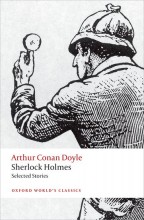 For over 100 years Oxford World’s Classics has made available the broadest spectrum of literature from around the globe. Each affordable volume reflects Oxford’s commitment to scholarship, providing the most accurate text plus a wealth of other valuable features, including expert introductions by leading authorities, voluminous notes to clarify the text, up-to-date bibliographies for further study, and much more. You can follow Oxford World’s Classics on Twitter, Facebook, or here on the OUPblog. Subscribe to only Oxford World’s Classics articles on the OUPblog via email or RSS.
For over 100 years Oxford World’s Classics has made available the broadest spectrum of literature from around the globe. Each affordable volume reflects Oxford’s commitment to scholarship, providing the most accurate text plus a wealth of other valuable features, including expert introductions by leading authorities, voluminous notes to clarify the text, up-to-date bibliographies for further study, and much more. You can follow Oxford World’s Classics on Twitter, Facebook, or here on the OUPblog. Subscribe to only Oxford World’s Classics articles on the OUPblog via email or RSS.
Subscribe to the OUPblog via email or RSS.
Subscribe to only literature articles on the OUPblog via email or RSS.
The post Sherlock Holmes’ beginnings appeared first on OUPblog.


By:
Mayra Calvani,
on 3/15/2014
Blog:
Mayra's Secret Bookcase
(
Login to Add to MyJacketFlap)
JacketFlap tags:
luthier,
lutherie,
Niccolo Paganini,
violin maker,
YA,
witchcraft,
young adult,
violin,
fantasy,
mystery,
Sherlock Holmes,
belgium,
dark fantasy,
sorcery,
brussels,
amateur detective,
Add a tag
I'm thrilled to announce that my latest book, The Luthier's Apprentice, featuring 16-year-old violin student/luthier/amateur sleuth Emma Braun, will be out in May 15th (ebook) and August 15th (print).
Niccolò Paganini (1782-1840), one of the greatest violinists who ever lived and rumored to have made a pact with the devil, has somehow transferred unique powers to another…
When violinists around the world mysteriously vanish, 16-year-old Emma Braun takes notice. But when her beloved violin teacher disappears… Emma takes charge. With Sherlock Holmes fanatic, not to mention gorgeous Corey Fletcher, Emma discovers a parallel world ruled by an ex-violinist turned evil sorceress who wants to rule the music world on her own terms.
But why are only men violinists captured and not women? What is the connection between Emma’s family, the sorceress, and the infamous Niccolò Paganini?
Emma must unravel the mystery in order to save her teacher from the fatal destiny that awaits him. And undo the curse that torments her family—before evil wins and she becomes the next luthier’s apprentice…

By: Alice,
on 9/9/2013
Blog:
OUPblog
(
Login to Add to MyJacketFlap)
JacketFlap tags:
Editor's Picks,
*Featured,
Physics & Chemistry,
Science & Medicine,
ciphers,
James O’Brien,
Scientific Sherlock Holmes,
typewritten documents,
Literature,
dogs,
Edgar Allan Poe,
sherlock holmes,
holmes,
fingerprints,
footprints,
handwriting,
arthur conan doyle,
forensic science,
sherlock,
Add a tag
By James O’Brien
Between Edgar Allan Poe’s invention of the detective story with The Murders in the Rue Morgue in 1841 and Sir Arthur Conan Doyle’s first Sherlock Holmes story A Study in Scarlet in 1887, chance and coincidence played a large part in crime fiction. Nevertheless, Conan Doyle resolved that his detective would solve his cases using reason. He modeled Holmes on Poe’s Dupin and made Sherlock Holmes a man of science and an innovator of forensic methods. Holmes is so much at the forefront of detection that he has authored several monographs on crime-solving techniques. In most cases the well-read Conan Doyle has Holmes use methods years before the official police forces in both Britain and America get around to them. The result was 60 stories in which logic, deduction, and science dominate the scene.
FINGERPRINTS
Sherlock Holmes was quick to realize the value of fingerprint evidence. The first case in which fingerprints are mentioned is The Sign of Four, published in 1890, and he’s still using them 36 years later in the 55th story, The Three Gables (1926). Scotland Yard did not begin to use fingerprints until 1901.
It is interesting to note that Conan Doyle chose to have Holmes use fingerprints but not bertillonage (also called anthropometry), the system of identification by measuring twelve characteristics of the body. That system was originated by Alphonse Bertillon in Paris. The two methods competed for forensic ascendancy for many years. The astute Conan Doyle picked the eventual winner.
TYPEWRITTEN DOCUMENTS
As the author of a monograph entitled “The Typewriter and its Relation to Crime,” Holmes was of course an innovator in the analysis of typewritten documents. In the one case involving a typewriter, A Case of Identity (1891), only Holmes realized the importance of the fact that all the letters received by Mary Sutherland from Hosmer Angel were typewritten — even his name is typed and no signature is applied. This observation leads Holmes to the culprit. By obtaining a typewritten note from his suspect, Holmes brilliantly analyses the idiosyncrasies of the man’s typewriter. In the United States, the Federal Bureau of Investigation (FBI) started a Document Section soon after its crime lab opened in 1932. Holmes’s work preceded this by forty years.
HANDWRITING
Conan Doyle, a true believer in handwriting analysis, exaggerates Holmes’s abilities to interpret documents. Holmes is able to tell gender, make deductions about the character of the writer, and even compare two samples of writing and deduce whether the persons are related. This is another area where Holmes has written a monograph (on the dating of documents). Handwritten documents figure in nine stories. In The Reigate Squires, Holmes observes that two related people wrote the incriminating note jointly. This allows him to quickly deduce that the Cunninghams, father and son, are the guilty parties. In The Norwood Builder, Holmes can tell that Jonas Oldacre has written his will while riding on a train. Reasoning that no one would write such an important document on a train, Holmes is persuaded that the will is fraudulent. So immediately at the beginning of the case he is hot on the trail of the culprit.
FOOTPRINTS
Holmes also uses footprint analysis to identify culprits throughout his fictional career, from the very first story to the 57th story (The Lion’s Mane published in 1926). Fully 29 of the 60 stories include footprint evidence. The Boscombe Valley Mystery is solved almost entirely by footprint analysis. Holmes analyses footprints on quite a variety of surfaces: clay soil, snow, carpet, dust, mud, blood, ashes, and even a curtain. Yet another one of Sherlock Holmes’s monographs is on the topic (“The tracing of footsteps, with some remarks upon the uses of Plaster of Paris as a preserver of impresses”).

CIPHERS
Sherlock Holmes solves a variety of ciphers. In The “Gloria Scott” he deduces that in the message that frightens Old Trevor every third word is to be read. A similar system was used in the American Civil War. It was also how young listeners of the Captain Midnight radio show in the 1940s used their decoder rings to get information about upcoming programs. In The Valley of Fear Holmes has a man planted inside Professor Moriarty’s organization. When he receives an encoded message Holmes must first realize that the cipher uses a book. After deducing which book he is able to retrieve the message. This is exactly how Benedict Arnold sent information to the British about General George Washington’s troop movements. Holmes’s most successful use of cryptology occurs in The Dancing Men. His analysis of the stick figure men left as messages is done by frequency analysis, starting with “e” as the most common letter. Conan Doyle is again following Poe who earlier used the same idea in The Gold Bug (1843). Holmes’s monograph on cryptology analyses 160 separate ciphers.
DOGS
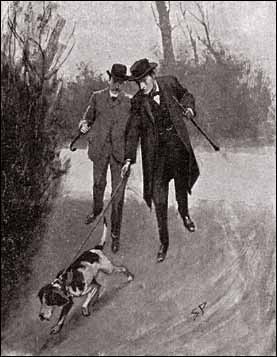 Conan Doyle provides us with an interesting array of dog stories and analyses. The most famous line in all the sixty stories, spoken by Inspector Gregory in Silver Blaze, is “The dog did nothing in the night-time.” When Holmes directs Gregory’s attention to “the curious incident of the dog in the night-time,” Gregory is puzzled by this enigmatic clue. Only Holmes seems to realize that the dog should have done something. Why did the dog make no noise when the horse, Silver Blaze, was led out of the stable in the dead of night? Inspector Gregory may be slow to catch on, but Sherlock Holmes is immediately suspicious of the horse’s trainer, John Straker. In Shoscombe Old Place we find exactly the opposite behavior by a dog. Lady Beatrice Falder’s dog snarled when he should not have. This time the dog doing something was the key to the solution. When Holmes took the dog near his mistress’s carriage, the dog knew that someone was impersonating his mistress. In two other cases Holmes employs dogs to follow the movements of people. In The Sign of Four, Toby initially fails to follow the odor of creosote to find Tonga, the pygmy from the Andaman Islands. In The Missing Three Quarter the dog Pompey successfully tracks Godfrey Staunton by the smell of aniseed. And of course, Holmes mentions yet another monograph on the use of dogs in detective work.
Conan Doyle provides us with an interesting array of dog stories and analyses. The most famous line in all the sixty stories, spoken by Inspector Gregory in Silver Blaze, is “The dog did nothing in the night-time.” When Holmes directs Gregory’s attention to “the curious incident of the dog in the night-time,” Gregory is puzzled by this enigmatic clue. Only Holmes seems to realize that the dog should have done something. Why did the dog make no noise when the horse, Silver Blaze, was led out of the stable in the dead of night? Inspector Gregory may be slow to catch on, but Sherlock Holmes is immediately suspicious of the horse’s trainer, John Straker. In Shoscombe Old Place we find exactly the opposite behavior by a dog. Lady Beatrice Falder’s dog snarled when he should not have. This time the dog doing something was the key to the solution. When Holmes took the dog near his mistress’s carriage, the dog knew that someone was impersonating his mistress. In two other cases Holmes employs dogs to follow the movements of people. In The Sign of Four, Toby initially fails to follow the odor of creosote to find Tonga, the pygmy from the Andaman Islands. In The Missing Three Quarter the dog Pompey successfully tracks Godfrey Staunton by the smell of aniseed. And of course, Holmes mentions yet another monograph on the use of dogs in detective work.
James O’Brien is the author of The Scientific Sherlock Holmes. He will be signing books at the OUP booth 524 at the American Chemical Society conference in Indiana on 9 September 2013 at 2:00 p.m. He is Distinguished Professor Emeritus at Missouri State University. A lifelong fan of Holmes, O’Brien presented his paper “What Kind of Chemist Was Sherlock Holmes” at the 1992 national American Chemical Society meeting, which resulted in an invitation to write a chapter on Holmes the chemist in the book Chemistry and Science Fiction. He has since given over 120 lectures on Holmes and science. Read his previous blog post “Sherlock Holmes knew chemistry.”
Subscribe to the OUPblog via email or RSS.
Subscribe to only science and medicine articles on the OUPblog via email or RSS.
Image credit: (1) From “The Adventure of the Dancing Men” Sherlock Holmes story. Public domain via Wikimedia Commons. (2) Sherlock Holmes in “The Adventure of the Missing Three-Quarter.” Illustration by Sidney Paget. Strand Magazine, 1904. Public domain via Wikimedia Commons.
The post Six methods of detection in Sherlock Holmes appeared first on OUPblog.

The first of Dynamite’s two new series announced today is Sherlock Holmes: Moriarty Lives, a five-issue miniseries focusing on Holmes’ second most menacing nemesis (the most terrifying of his villains being, of course, the opium den). Written by David Liss and drawn by Daniel Indro, the series will come with covers from Francesco Francavilla. Like this one, in fact!
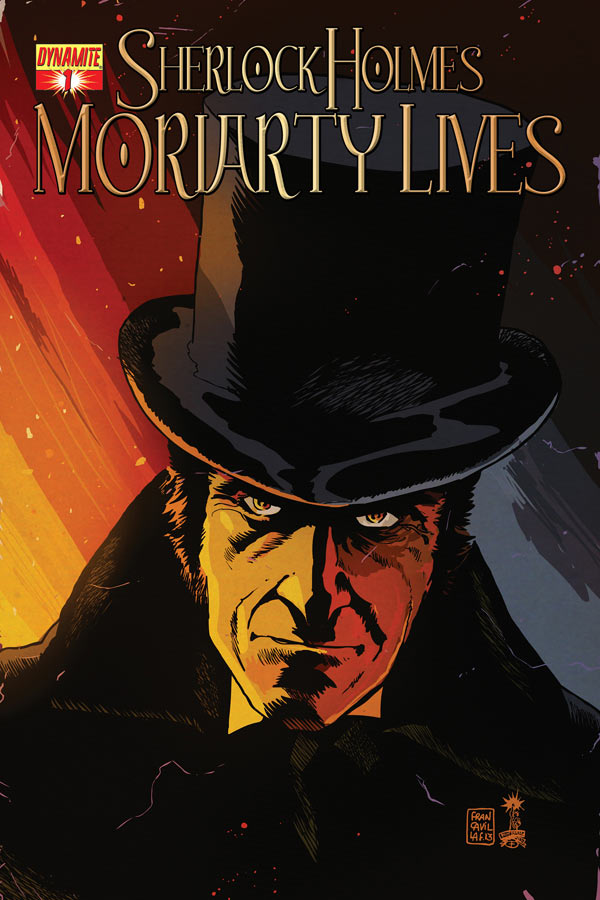
Out in December, Liss promises that this will in fact be a Holmes-free storyline, instead focusing on Moriarty independently. Not much is revealed about the premise of the storyline beyond the idea that Moriarty will be pursuing a venture which looks to help some people in need – but also make him some money at the same time.
No one is the villain of their own narrative, and no one is evil all the time, so I thought it be fun to tell a story about a very bad man who finds himself in a situation in which he chooses to be good — mostly. At least a little. This story is going to take place right after the Arthur Conan Doyle story, “The Final Problem,” in which both presumably die in Switzerland. What if Moriarty survived the fall? Where did he go?
Liss and Indro are both well-known to Dynamite readers, for their work on books like The Shadow and Green Hornet, respectively. Indro will also be providing covers for the series, including this one set mere moments after The Final Problem:
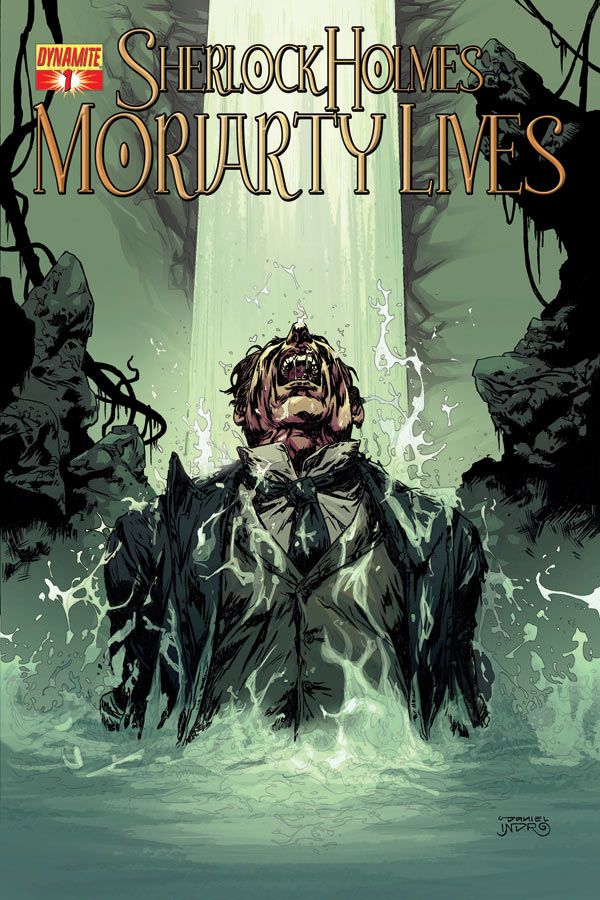
A week or so ago, the US broadcast networks announced their lineup of new and returning shows for the fall of 2013, and since then the internet's premier TV sites have been abuzz with a flurry of analysis. Trailers have been dissected, ratings and demographics calculated, schedules critiqued. It's all a lot of fun, in an inside baseball sort of way, but in the midst of all this excitement, it's

By: sylvandellpublishing,
on 4/17/2013
Blog:
Sylvan Dell Publishing's Blog
(
Login to Add to MyJacketFlap)
JacketFlap tags:
Children's Books,
fun,
picture books,
math,
animals,
sherlock holmes,
educational,
detective,
duck,
Sylvan Dell,
educational books,
logic,
Sylvan Dell Posts,
deductive detective,
deductive reasoning,
for creative minds,
Add a tag

“Eliminate all other factors, and the one which remains must be the truth,” Sherlock Holmes has said about his method of detective work. In Sylvan Dell’s new picture book, Deductive Detective, our hero Detective Duck shows that he’s learned from the best! He dons his best deerstalker hat, his much-too-big magnifying glass, and solves the case of the missing cake with the same methods the pros use!
That is, a style of logical thinking called “deductive reasoning.” In deductive reasoning, someone finds an answer they’re looking for by first finding out what the answer isn’t. When Detective Duck examines the clues and finds out which of his friends couldn’t have stolen the cake, it leads him closer to what really happened!
Of course, you don’t need a weird hat and a magnifying glass to use deductive reasoning. These methods come in handy every day! If you lose a toy, for example (or car keys), you may make your search easier by determining where the item isn’t.
“Oh yeah,” you may say, “I didn’t bring it to my friend’s house; I wasn’t holding it when I walked to the living room, or landed on the moon. I wouldn’t have brought it to my parents’ room or under the ocean or into Mordor.” By deciding where you shouldn’t look, you now have a better idea of where you should.
This kind of logic process happens throughout the day, sometimes without you even being aware of it; you might say your brain is always on the case as much as any detective!
Apply deductive reasoning the next time you’re in the bookstore: subtract the books that don’t meet the highest educational standards, offer pages of activities and facts, offer online supplements, are fun to look at and fun to read! You’ll be left with books by Sylvan Dell like The Deductive Detective!


 Scholar Leslie S. Klinger has filed a civil suit in federal court against the Arthur Conan Doyle Estate, hoping to prove that “Sherlock Holmes and Dr. John H. Watson are no longer protected by federal copyright laws.”
Scholar Leslie S. Klinger has filed a civil suit in federal court against the Arthur Conan Doyle Estate, hoping to prove that “Sherlock Holmes and Dr. John H. Watson are no longer protected by federal copyright laws.”
The suit was filed in the U.S. District Court for the Northern District of Illinois. Along with Laurie R. King, Klinger edited A Study in Sherlock: Stories Inspired by the Sherlock Holmes Canon. He was working on a new collection called In the Company of Sherlock Holmes with stories by Sara Paretsky, Michael Connelly, Lev Grossman and more. He made his case, in the release:
The Conan Doyle Estate contacted our publisher … and implied that if the Estate wasn’t paid a license fee, they’d convince the major distributors not to sell the book. Our publisher was, understandably, concerned, and told us that the book couldn’t come out unless this was resolved … It is true that some of Conan Doyle’s stories about Holmes are still protected by the U.S. copyright laws. However, the vast majority of the stories that Conan Doyle wrote are not. The characters of Holmes, Watson, and others are fully established in those fifty ‘public-domain’ stories. Under U.S. law, this should mean that anyone is free to create new stories about Holmes and Watson.
New Career Opportunities Daily: The best jobs in media.
View Next 25 Posts






















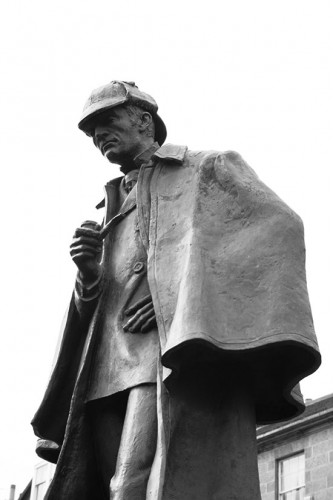


 For over 100 years
For over 100 years 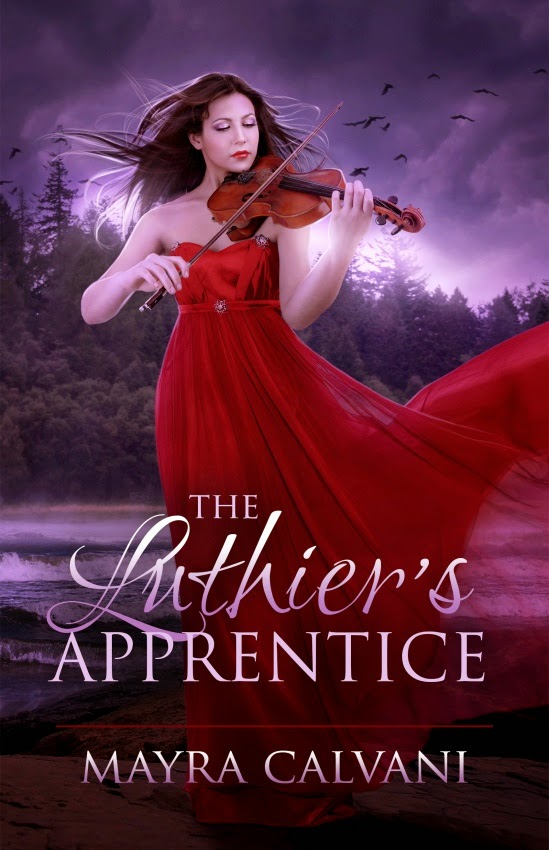
 Conan Doyle provides us with an interesting array of dog stories and analyses. The most famous line in all the sixty stories, spoken by Inspector Gregory in Silver Blaze, is “The dog did nothing in the night-time.” When Holmes directs Gregory’s attention to “the curious incident of the dog in the night-time,” Gregory is puzzled by this enigmatic clue. Only Holmes seems to realize that the dog should have done something. Why did the dog make no noise when the horse, Silver Blaze, was led out of the stable in the dead of night? Inspector Gregory may be slow to catch on, but Sherlock Holmes is immediately suspicious of the horse’s trainer, John Straker. In Shoscombe Old Place we find exactly the opposite behavior by a dog. Lady Beatrice Falder’s dog snarled when he should not have. This time the dog doing something was the key to the solution. When Holmes took the dog near his mistress’s carriage, the dog knew that someone was impersonating his mistress. In two other cases Holmes employs dogs to follow the movements of people. In The Sign of Four, Toby initially fails to follow the odor of creosote to find Tonga, the pygmy from the Andaman Islands. In The Missing Three Quarter the dog Pompey successfully tracks Godfrey Staunton by the smell of aniseed. And of course, Holmes mentions yet another monograph on the use of dogs in detective work.
Conan Doyle provides us with an interesting array of dog stories and analyses. The most famous line in all the sixty stories, spoken by Inspector Gregory in Silver Blaze, is “The dog did nothing in the night-time.” When Holmes directs Gregory’s attention to “the curious incident of the dog in the night-time,” Gregory is puzzled by this enigmatic clue. Only Holmes seems to realize that the dog should have done something. Why did the dog make no noise when the horse, Silver Blaze, was led out of the stable in the dead of night? Inspector Gregory may be slow to catch on, but Sherlock Holmes is immediately suspicious of the horse’s trainer, John Straker. In Shoscombe Old Place we find exactly the opposite behavior by a dog. Lady Beatrice Falder’s dog snarled when he should not have. This time the dog doing something was the key to the solution. When Holmes took the dog near his mistress’s carriage, the dog knew that someone was impersonating his mistress. In two other cases Holmes employs dogs to follow the movements of people. In The Sign of Four, Toby initially fails to follow the odor of creosote to find Tonga, the pygmy from the Andaman Islands. In The Missing Three Quarter the dog Pompey successfully tracks Godfrey Staunton by the smell of aniseed. And of course, Holmes mentions yet another monograph on the use of dogs in detective work.




I very rarely read adult novels (no more than half dozen a year), but Woodson could release 500 pages with the word “applesauce” typeset on only one of them, and I would read it.
Bring on Another Brooklyn!
I’ve read Elisha’s book. It’s really quite good.
(The new one, that is, but BOTH are good!)
A biography of Garth Williams with his illustrations? Who wouldn’t want to read that!
can’t wait for the julian barnes!